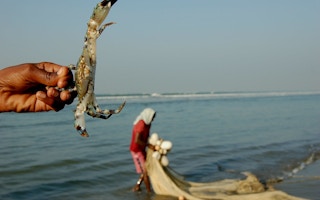Crab farmers and traders in Bangladesh’s coastal areas are on the brink of destitution as exports are indefinitely postponed after the Covid-19 outbreak. The losses started well before the pandemic reached Bangladesh, because China – the main market for the crabs – imposed an import ban on January 25.
Swapan Mandal, general secretary of the Rampal-Bagerhat Crab Dealers Association, said that large quantities of crabs were usually sold during the Chinese New Year festival. But due to this year’s ban, many crabs have died already.
Crabs produced in the country’s three coastal districts around the Sundarbans — the world’s largest mangrove forest that straddles the Bay of Bengal coastline of Bangladesh and India — are also exported to Japan, Taiwan, Belgium, Britain, the Netherlands, Germany and Australia. China accounts for around 85 per cent of the exports.
Kazi Mahabubul Alam Azad, Secretary of the Bangladesh Live Crab and Eel fish exporters Association, said the export of crabs to China had been totally suspended from January 25 to mid-February. “Later we started exports to some provinces of China at a very limited scale. But from March 23, the exports were stopped again as the Bangladesh government has shut all airports in this country. If the situation improves the exports may resume on April 5.”
“But the main problem is that we have not got any payment for what has been exported already this year. Our buyers have not paid us yet.”
The loss in this sector has reached BDT 4 billion (USD 46.90 million) already, Azad estimated. “The marginal farmers are facing most of the losses.” The industry employs nearly 500,000 farmers, most of them with very small landholdings and living below the poverty line.
“After January 25, we were exporting only a few consignments to the European market, on a very limited scale.” Azad said. With the suspension of flights, that market has also closed down. “It will be a disaster for us if the situation does not improve and we are not able to export again soon.”
Price crash
As demand crashed, the price of crabs in the domestic market has fallen by two-thirds. “We used to sell quality crab at BDT 2,500 (USD 30) per kg, which is now around BDT 800-900 (USD 9.40-10.50),” Azad said.
And even at the price, there is a lot of unsold stock, as local consumption of crab and eel is low. Bangladesh’s crab farmers are almost entirely dependent on exports.
The once buzzing crab and eel markets in the coastal districts Khulna, Bagerhat and Satkhira are now deserted.
Tapash Mandal, a crab farmer in Saral village of Paikgachha sub-district in Khulna district, borrowed BDT 450,000 (USD 5,300) and started fattening crabs in a one-acre plot that is periodically inundated by brackish water. Buying one kilogram of female crab at BDT 500 (USD 6), he used to sell them for BDT 1,500 to BDT 1,800 (USD 18-21) after fattening.
“But this year I could sell crab worth Tk 30,000 (USD 354) only. I had nearly one ton of crabs in my farm which I could not export. All of them died. I sold only a little in the local market. I have lost almost BDT 700,000 (USD 8,200) this season. I’m not sure how I’m going to repay my debt.”
Climate change impact
Many farmers in Khulna, Bagerhat and Satkhira had been forced from paddy to shrimp farming two to three decades ago, as sea level rise due to climate change made the water and the soil too saline for paddy. But shrimps are highly vulnerable to diseases, especially when packed as they are in the shallow brackish waters of the shrimp farms.
So many shrimp farmers moved to crabs, initially lured by the promise of a lucrative market in Japan. Over the last five years or so, crab fattening and eel farming have become very popular in the coastal districts due to the high prices they attract in international markets.
In the financial year from April 2007 to March 2008, Bangladesh’s earnings from crab exports totalled USD 7 million. There has been a big increase since then.
The situation is affecting everyone from large traders to labourers. Mrinal Kanti Dey, vice-president of Sundarban Crab and Fisheries Cooperative Society, told The Daily Star, “I usually trade around 800-900 kg every day; but now it has come down to 200-250 kg as export to foreign markets, especially China, has stopped since January 25.”
Shibpada Biswas from Khalsibunia village in Batiaghata sub-district of Khulna has been catching crabs from the creeks in the Sundarbans for the last 25 years. But this January he has had to change his profession. He is now working as a labourer.
“I never saw a situation like this in my life. Now there is no demand for crab. Large crabs used sell for to be BDT 1,500 (USD 18) a kilogram. Now nobody is buying them at BDT 500 (USD 6),” in the domestic market.
This story was published with permission from The Third Pole.














